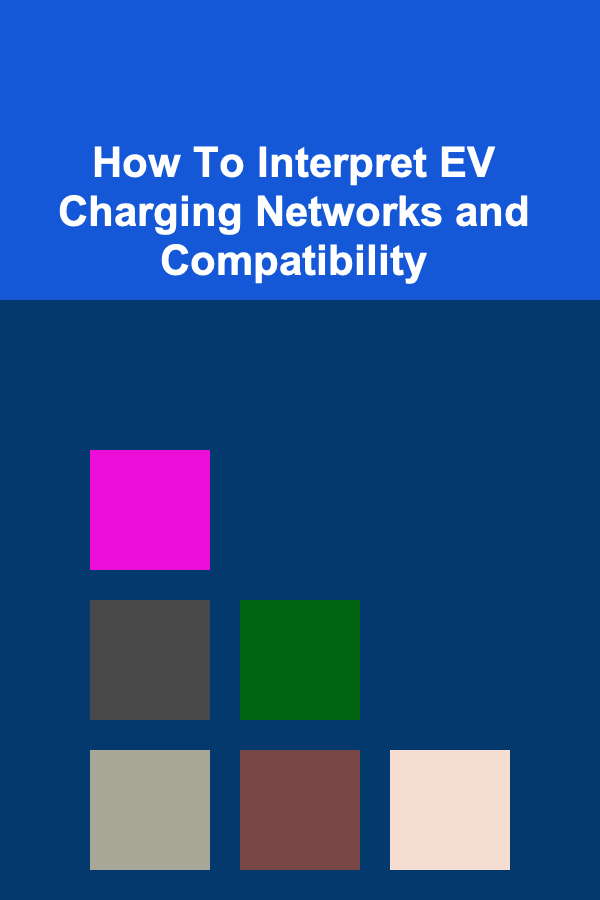
How To Interpret EV Charging Networks and Compatibility
ebook include PDF & Audio bundle (Micro Guide)
$12.99$7.99
Limited Time Offer! Order within the next:

Electric vehicles (EVs) are becoming increasingly popular as a sustainable alternative to traditional gasoline-powered vehicles. However, the adoption of EVs comes with its own set of challenges, one of the most critical being the availability and compatibility of charging networks. The transition to electric mobility requires not only a robust infrastructure but also an understanding of how various charging networks operate, how to interpret them, and how to ensure compatibility with different EV models.
This article provides an in-depth analysis of EV charging networks, covering the types of charging stations, network operators, compatibility issues, and how to interpret the vast array of charging options available to EV owners. We will explore the challenges and solutions in the EV charging ecosystem, the technological standards involved, and the steps necessary for ensuring a smooth and efficient charging experience for all.
The Evolution of EV Charging Networks
As the world moves towards more sustainable transportation solutions, the development of EV charging infrastructure has been growing rapidly. Early on, EV owners faced limited options for charging their vehicles. Charging stations were sparse, often located in niche markets or exclusive areas. Over time, however, governments, private companies, and other stakeholders have recognized the importance of a comprehensive and accessible charging network.
Today, there are various charging network providers that manage a mix of home, public, and commercial charging infrastructure. These providers ensure that users can charge their vehicles at a variety of locations, but with this development comes the challenge of compatibility. The technology behind these networks has evolved, with differing connectors, charging speeds, payment systems, and user interfaces that can create confusion for new and experienced EV owners alike.
Types of EV Charging Stations
EV charging stations are typically categorized based on the charging speed and the type of power supply they provide. These stations can be classified into three primary types: Level 1, Level 2, and DC Fast Charging.
1. Level 1 Charging
Level 1 charging is the most basic type of EV charging and uses a standard 120-volt outlet found in most homes. It is typically used for overnight charging, as it delivers a relatively low power output (around 1.3 kW). This means it takes much longer to charge an EV compared to other methods. For example, a full charge on a typical EV might take up to 24 hours using a Level 1 charger. Despite its slow speed, Level 1 charging is a convenient option for individuals with access to home charging.
2. Level 2 Charging
Level 2 charging stations provide a faster charge than Level 1 by using a 240-volt outlet, which is the same type of outlet used for large household appliances like dryers. These chargers can deliver between 3.3 kW to 19.2 kW of power, significantly reducing charging times. A full charge on a typical EV using Level 2 charging might take between 4 to 10 hours, depending on the battery size and charging rate.
Level 2 chargers are commonly found in public locations such as parking lots, workplaces, and EV charging stations, making them the most commonly used type for public charging. Many EV owners install Level 2 charging stations at home to enjoy faster charging speeds.
3. DC Fast Charging (Level 3)
DC Fast Charging, or Level 3 charging, is the fastest charging option available. These stations use direct current (DC) rather than alternating current (AC), allowing for much higher charging rates. DC Fast Chargers can provide power from 25 kW to 350 kW or more, enabling an EV to be charged to 80% in as little as 20 to 40 minutes. This makes DC Fast Charging ideal for long-distance travel and highway routes, where fast refueling is needed.
While DC Fast Chargers are crucial for long trips and highway networks, they are typically more expensive to install and maintain. They are found primarily along major highways and in urban areas with high demand for fast charging.
EV Charging Networks: Key Players and Operators
The EV charging ecosystem is made up of numerous operators, each with their own networks, pricing models, and geographical reach. Some of the major players in the global EV charging market include:
1. Tesla Supercharger Network
Tesla's Supercharger network is one of the most recognized and widely used EV charging systems in the world. Tesla vehicles are equipped with proprietary connectors that only fit Tesla Superchargers, making this network unique in terms of compatibility. The network offers high-speed DC Fast Charging, enabling Tesla vehicles to charge quickly while on the road. However, Tesla has opened up its network in some regions to non-Tesla EVs, increasing its accessibility.
2. ChargePoint
ChargePoint is one of the largest independent EV charging networks, with thousands of Level 2 and DC Fast Charging stations across North America and Europe. ChargePoint offers a variety of charging solutions, including home chargers, workplace chargers, and public charging stations. The network is compatible with most EV models, making it a popular choice for non-Tesla owners.
ChargePoint's mobile app allows users to find nearby charging stations, check availability, and make payments directly. They also offer various pricing models, including subscription plans and pay-per-use charges.
3. Blink Charging
Blink Charging is another large operator in the EV charging space, providing both Level 2 and DC Fast Charging stations. Blink operates a large network of public charging stations, with a significant presence in the U.S. and growing footprints in other countries. Like ChargePoint, Blink also offers a mobile app to locate chargers, monitor charging sessions, and pay for services.
Blink's pricing structure varies depending on the location and charging speed, and the company continues to expand its network through partnerships with businesses and municipalities.
4. Electrify America
Electrify America is an electric vehicle charging network that focuses primarily on DC Fast Charging stations. It was founded by Volkswagen Group of America as part of their settlement from the Dieselgate scandal. Electrify America has rapidly expanded, providing fast-charging infrastructure along major highways and urban areas.
Electrify America supports a wide range of EVs, including models from brands like Audi, Ford, and BMW, providing high-speed charging for most EVs on the market. Users can locate stations, track charging status, and pay via the Electrify America mobile app.
5. EVgo
EVgo operates one of the largest DC Fast Charging networks in the U.S., with a focus on high-traffic locations like shopping centers, restaurants, and other commercial properties. The network supports several types of connectors, including CHAdeMO, CCS, and Tesla connectors in some regions. EVgo is known for its fast-charging capabilities, with charging speeds up to 350 kW.
EV Charging Compatibility: Understanding Connectors and Standards
A key challenge in the EV charging landscape is the lack of universal charging standards. Different EV manufacturers use different types of connectors, which can create confusion for drivers who want to use various public charging stations. Understanding these standards is crucial for ensuring compatibility.
1. Charging Connectors
EVs use several types of charging connectors depending on the region and manufacturer. The most common connectors include:
- Type 1 (J1772): Commonly used in North America and Japan for Level 1 and Level 2 charging. This connector is widely compatible with most non-Tesla EVs.
- Type 2 (Mennekes): The standard charging connector used in Europe for Level 2 charging. This connector is widely used for AC charging and is compatible with most European EVs.
- CHAdeMO: A DC fast charging connector used primarily by Japanese manufacturers such as Nissan and Mitsubishi. It is commonly found at DC Fast Charging stations.
- CCS (Combined Charging System): A newer standard for DC Fast Charging that is used by many European and American manufacturers. CCS offers higher charging speeds and is becoming the global standard for fast charging.
2. Regional Differences
The charging standards used in different regions can create compatibility issues for international EV owners. For example, while the Type 2 connector is standard in Europe, American vehicles typically use the J1772 connector. Furthermore, the CCS standard is used for fast charging in both Europe and North America, but some regions may have different charging speeds depending on the infrastructure.
3. Proprietary Connectors
Some automakers, such as Tesla, have developed their own proprietary connectors. Tesla's Supercharger network, for example, uses a unique connector that only works with Tesla vehicles. However, Tesla has begun opening up its network to other EVs in certain countries, making it more accessible for non-Tesla owners.
Challenges in EV Charging Network Compatibility
As EV adoption grows, several challenges related to charging network compatibility have emerged. These challenges include:
1. Different Charging Speeds
Not all charging stations provide the same charging speeds, and the availability of fast chargers may not be consistent across different regions. While DC Fast Charging stations are ideal for long-distance travel, the availability of such chargers can be limited, and some areas may only offer Level 1 or Level 2 chargers.
2. Charging Network Fragmentation
The EV charging market is fragmented, with many different network operators and charging standards. This can create confusion for EV owners who may need to use multiple apps or payment systems to access charging stations. Fragmentation also leads to issues with station availability, pricing structures, and user interfaces.
3. Payment Systems and Accessibility
The diversity of payment systems across networks can make it difficult for users to find the most efficient way to pay for charging. Some stations require subscriptions, while others operate on a pay-per-use basis. Inconsistent payment methods and pricing can complicate the user experience, especially for those who need to charge on the go.
Solutions for Overcoming Compatibility Issues
To address the challenges surrounding EV charging network compatibility, several solutions have been proposed or implemented:
1. Standardization of Charging Connectors
Governments and industry groups are working towards the standardization of connectors to reduce compatibility issues. The widespread adoption of the CCS standard for DC Fast Charging is a step in the right direction, and efforts to harmonize charging standards across regions continue.
2. Cross-Network Roaming
Cross-network roaming agreements allow EV owners to access multiple charging networks using a single account or payment system. By allowing drivers to use a single app or payment method across different networks, these agreements streamline the charging experience and reduce fragmentation.
3. Integration of Charging Platforms
Charging platforms like PlugShare and ChargeHub help users find and navigate various charging networks. These platforms provide real-time data on charging station availability, pricing, and network compatibility, making it easier for EV owners to plan their trips and find the right charging station.
4. Government Incentives and Investments
Governments are also investing in the expansion of public charging infrastructure to ensure that charging stations are more accessible and compatible. Incentives for charging station operators and subsidies for EV owners can accelerate the growth of the charging network, making it easier to find compatible stations.
Conclusion
As the EV market continues to grow, understanding the nuances of EV charging networks and compatibility becomes increasingly important. The challenges of varying charging speeds, different connector standards, and fragmented networks can make charging a complex experience for many users. However, ongoing efforts to standardize charging infrastructure, expand cross-network interoperability, and improve accessibility will help pave the way for a more streamlined and efficient charging experience.
EV owners must stay informed about the various networks, connectors, and payment systems available to them. As the charging infrastructure continues to evolve, it is essential for users to interpret the available charging options and understand how to navigate this complex landscape to maximize the convenience and efficiency of their EV experience.

How to Make Money Online as a Content Creator: 10 Actionable Ideas
Read More
How to Manage Your Pet's Bathing Routine at Home
Read More
How To Understand Card-Driven Board Games
Read More
Meal Planning on a Budget: Delicious Meals Without the High Cost
Read More
Top 5 Tools to Organize Your Remote Job Search
Read More
How to Use AI for Recommendation Systems
Read MoreOther Products

How to Make Money Online as a Content Creator: 10 Actionable Ideas
Read More
How to Manage Your Pet's Bathing Routine at Home
Read More
How To Understand Card-Driven Board Games
Read More
Meal Planning on a Budget: Delicious Meals Without the High Cost
Read More
Top 5 Tools to Organize Your Remote Job Search
Read More